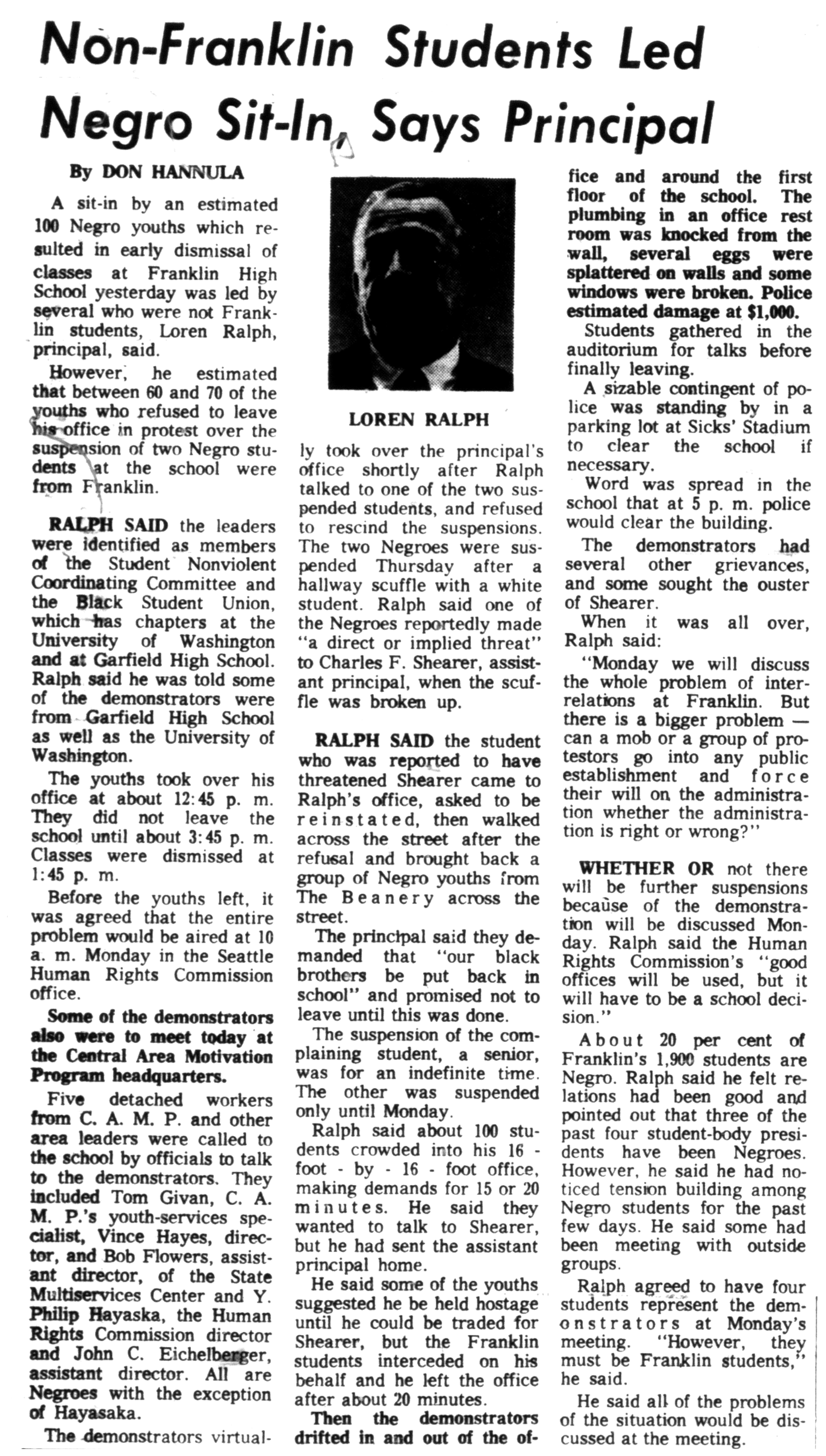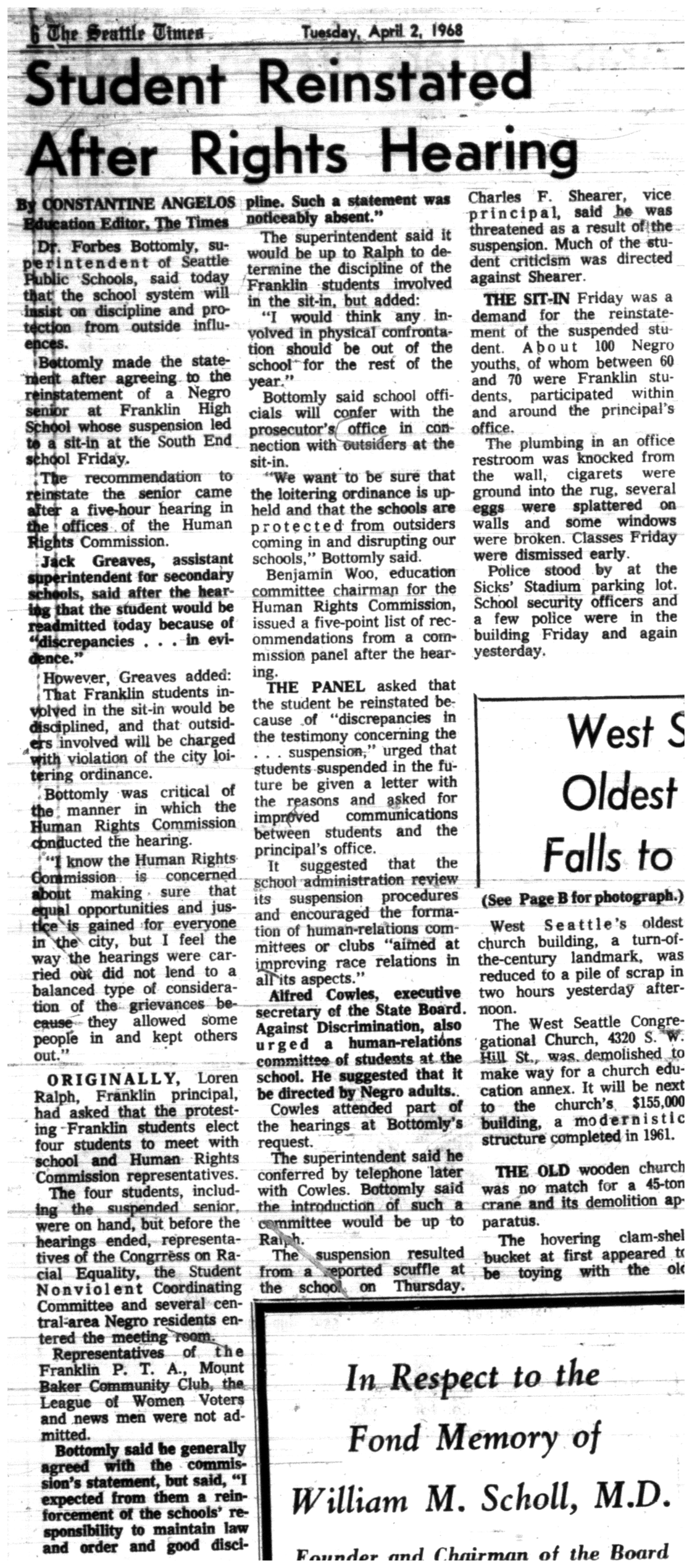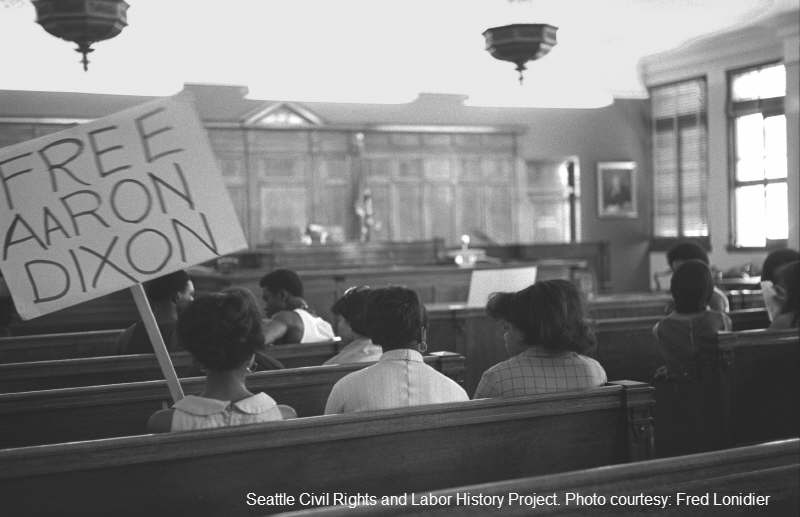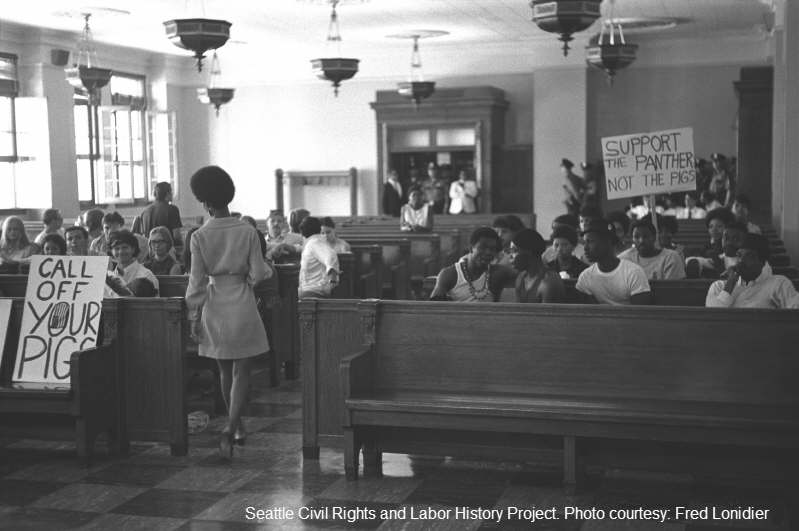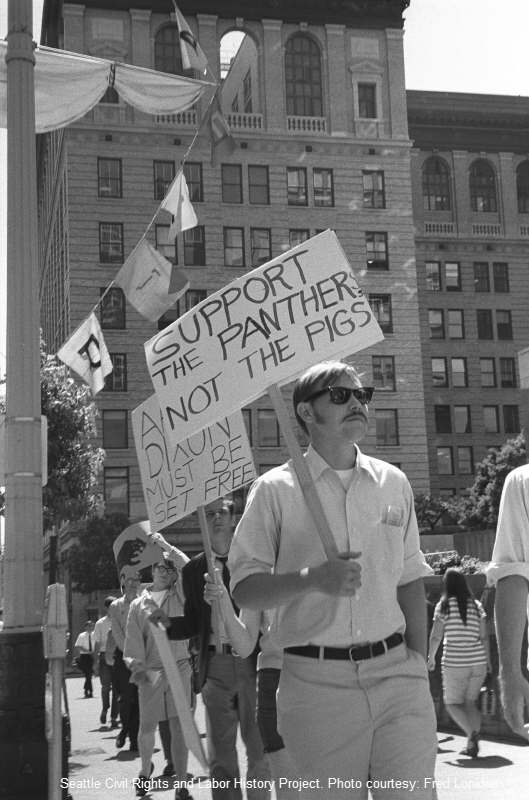When two young African American students were suspended from Seattle's Franklin High School in March of 1968 after an altercation with a Caucasian student, who was not reprimanded, the stage was set for one of the most significant events of the Seattle civil rights movement. Following the suspensions, Franklin's black students were in an uproar. They immediately contacted a group of African American students at the University of Washington who had been trying to start a Black Student Union at Franklin. This essay explains the involvement of this group of college students in the fight to earn equal opportunities for African American students. The sit-in at Franklin High that they helped engineer was one of the first Black Power demonstrations in Seattle. It rattled the surrounding community, inspired the formation of the Seattle chapter of the Black Panther Party, and brought the existence of a militant civil rights movement in the Pacific Northwest to the attention of the entire nation.
ORIGINS OF THE FRANKLIN SIT-IN
There is some confusion about the origins of the sit-in at Franklin High. Larry Gossett remembers the principal of Franklin, Loren Ralph, suspending two female students for wearing a popular hairstyle for African Americans, known as the Afro. Gossett recalled that Ralph told the young women that they could return to school when they learned to look more “lady-like."[2]
Contemporary sources reveal a different story, however. The demonstration was prompted by Ralph’s decision to suspend two African American students who were involved in a hallway scuffle on March 28, 1968. Three male students took part in the fight, however only cousins Charles Oliver and Trolice Flavors were reprimanded. The third participant, who was Caucasian, was not. While Oliver’s suspension would not take effect until the following Monday, Flavors was accused of making a physical threat to Franklin vice Principal Charles F. Shearer and was suspended immediately and indefinitely. Concerned about the welfare of his education, Flavors, a senior, requested to speak with Ralph in order to negotiate his suspension and contest the alleged threat to Shearer. When it became apparent to Flavors that he would not be reinstated, he contacted his mentor, Carl Miller, who was a member of the Black Student Union at the University of Washington.[3]
The Black Student Union (BSU) was a new organization on the University of Washington campus. Founded January 6, 1968 by members of the Student Nonviolent Coordinating Committee (SNCC), it cultivated the appreciation of African American culture and social reform for minority students. Comprised of predominately black people from the United States, Africa, and other countries, the University of Washington BSU was part of a nationwide movement of black student organization in the late 1960s. Targeting university curriculum and hiring practices, the BSU hoped to “Establish a cohesive union of black students, black faculty, other black organizations, and the community to facilitate educational opportunities." According to the group's mission statement, "BSU exists to enhance cultural awareness, political awareness, social events, and to provide support for the students and the community.”[4] Charging the university with insensitivity toward black heritage, the organization’s activism laid the foundation for the American Ethnic Studies department and eventually pushed the university to create an Equal Opportunity Program and support students of color through an Office of Minority Affairs.
Soon after being contacted by Flavors, Carl Miller spoke with Dr. Eugene Elliott, an assistant to University of Washington president Charles Odegaard, and asked him to arrange a meeting with Ralph for the following morning. The plan was for Miller and BSU co-founders Aaron Dixon and Larry Gossett to convince Ralph to reinstate the two Franklin students. This would be the UW BSU’s first high profile action. To the three men, it was imperative to fight the issue as a matter of principle and because, as Miller put it, “The Black Student Union encourages black brothers and sisters to stay in school.”[5]
The BSU's attempt to resolve the issue through negotiations proved unsuccessful, and this setback became the catalyst for the demonstration at Franklin later that day. Angered that Ralph was un-receptive to the peaceful negotiations of the BSU students, African American Franklin students wanted to “burn the school down,” but Aaron Dixon convinced the group of students “that if there was no Franklin none of them could further their education.”[6] As reported in the Seattle Post Intelligencer, Dixon, Gossett, and Miller instructed the students to gather at a local eatery called “The Beanery” across the street from the school, to alleviate a potentially violent situation.[7] There, the three UW students formulated a plan of action that would peacefully yet effectively get their point across: racial discrimination would no longer be tolerated within the Seattle Public school system. According to Dixon, “Carl Miller and I … brought the students out (of the Beanery) and formed them in twos. We felt if we were going to do any demonstrating, it should be done in a peaceful and orderly manner.”[8]
At 12:45 p.m. 100 students, including roughly 40 non-Franklin students, marched into Principal Ralph’s office, chanting “Ungowa, BLACK POWER!” They demanded, first and foremost, that Ralph immediately reinstate Trolice Flavors and Charles Oliver. Alongside this, the student's made three other demands: 1) that a black administrator be hired at the high school level in the Seattle Public School system; 2) that an African American history class be taught at Franklin; and 3) that images of black heroes grace the school walls along with the other American historical figures already featured.
It was the first time a sit-it had been held at a high school in the Seattle area, and Ralph as well as other school officials did not know how to react. When it became obvious to Ralph that the demonstrators were not going to leave until their demands were met, he dismissed all Franklin students and faculty to ensure their "safety."[9] There was no violence imposed on Ralph or anyone else. While 2,000 people left Franklin at 1:45 p.m. the demonstrators remained firm, and did not leave school grounds until 3:45 pm. With so many students trying to get their point across, things did become somewhat unruly. But as Carl Miller later assured reporters, the BSU was not there to inflame the situation but rather as a focused means of guidance. “We went there to keep things down,” he said.[10]
Seattle police closed off the school building from the public and patrolled the grounds so that demonstrators inside the building would not be able to leave. Mediators from several local minority empowerment groups, including the Central Area Motivating Program (CAMP), the state Multiservice Center, and Seattle schools’ Intergroup Relations Office were called in to urge the students from Franklin and the University of Washington to leave the administration offices and take their cause to the auditorium – a larger location better suited to fit all 100 students. After some hesitation, the demonstrators agreed, but insisted that they would not completely exit Franklin grounds until Ralph met their demands. Instead, school officials, mediators, and students arranged a meeting for the following Monday to discuss the demands and the issue of racial discrimination in the Seattle Public School system. This compromise allowed the demonstration to end peacefully. The only damage was in Principal Ralph’s office restroom, where the sink had been disconnected from the wall due to the excessive in and out flow of students during the demonstration.[11]
A five hour hearing was held the following Monday at the Seattle Human Rights Commission office. At the hearing, Seattle Public Schools Superintendent Dr. Forbes Bottomly announced that one of the two suspended students would be reinstated. However, he also insinuated that the King County prosecutor’s office would be asked to press charges against UW BSU leaders for their role in the protest. Bottomly claimed: “we want to be sure that the loitering ordinance is upheld and that the schools are protected from outsiders coming in and disrupting our schools.”[12]
THE ARRESTS
Carl Miller, Aaron Dixon, Larry and Richard Gossett, and Trolice Flavors were arrested for their participation in the Franklin High School sit-in at approximately 8:30 a.m. on April 4th, 1968; later that same day, the Reverend Dr. Martin Luther King, Jr. was assassinated. The students were charged with unlawful assembly. Although the five men had been involved in various forms of community activism and protest in the past, this was the first time any of them had been arrested and taken to jail. They knew that the sit-in had gained a lot of exposure because it was headline news in many Seattle publications; however, they did not believe what they had done warranted arrest. They had assembled for a just cause and adjourned the premises of Franklin peacefully and non-violently. As such, they viewed the decision to press charges as clearly a politically motivated act. Never to be discouraged, the five men were confident that justice would ultimately prevail. Although the BSU students were not regretful about their participation in the sit-in, it appeared that the general non-black population felt differently. A quote from Principal Loren Ralph best exemplifies the prevailing sentiment: “Can a mob or group of protestors go into any public establishment and force their will on administration whether the administration is right or wrong?”[13] The students didn’t have mainstream support, but they did have the support of many in the Seattle community.
The BSU leaders were taken to King County jail, which, ironically, is now the newly remodeled office of present day county councilman Larry Gossett. For all of the insinuations about the BSU students being troublemakers, jail officials labeled Miller, Gossett, and Dixon “peacemakers” during their time in prison. As stated earlier, the five young men were arrested the morning of Dr. Martin Luther King’s assassination. Citizens across the nation were deeply saddened by King’s death; a leader was lost but there was also the sense that the non-violent approach to civil rights was being replaced by intense angst and disillusionment and a call for immediate action by youthful revolutionaries. Riots broke out in cities such as Washington D.C., Chicago, IL, and Baltimore, MD. Crowds of people were angry and felt betrayed by the lack of progress in racial equality. The jail in Seattle was also in an uproar following the disheartening news of Dr. King’s death, and there was talk of a riot. Gossett recalled that
About six or seven hours after we got in jail, news came that Martin Luther King, Jr. had been assassinated. And the black prisoners, their conception of black power was that they were going to go beat up these white prisoners.[14]
Dixon, Gossett, and Miller counseled against any violence, persuading the inmates that taking out their anger in a violent fashion would not honor Dr. King’s legacy. The BSU leaders decided to gather all inmates and encourage them to talk about their personal problems and current world affairs. Prison officials did not know how to react. They expected violence, especially from African American men. Three young college educated black men were helping to assist a peaceful congregation of inmates, encouraging them to verbally, and non-violently, express their feelings as a means for solving problems. Nevertheless, jail officials saw the meetings as threatening. According to Gossett, “Word got out later that night we were having discussions throughout the whole jail. By that (next) morning, the director of the King County Jail was demanding that the three of us get put out of jail.”[15] A hearing date for the three men was expedited as a means to prevent any more gathering and discussion amongst the inmates.
THE HEARING
The initial hearing for four of the five defendants in the Franklin High sit-in case was held April 5th, 1968. Since Richard Gossett had voluntarily surrendered to the police, he was not included in the arraignment hearing. The others were escorted into the courtroom in chains. Gossett remembers:
We were in there for a misdemeanor, but they had, I think it was, the three of us handcuffed around here [wrists], around our waist, around our ankles. It was very symbolic of slavery. They had the guards holding the chains, about four feet in back of us, as they brought the three of us in court, you know, like we were the coldest murderers that ever hit Seattle, not some people that had been busted for a misdemeanor unlawful assembly charge, but that’s how they saw it.[16]
It was just a preliminary hearing, not a trial, but the public support for the defendants was astonishing. According to accounts in the Seattle P.I. several hundred people showed up for Gossett, Flavors, Miller, and Dixon.[17]
The purpose of the hearing was to see if Judge James J. Dore would uphold the original ruling of Justice Court Judge Evans D. Mapolides, to hold the four defendants in jail on $1,500 bail until their trial. A nervous feeling hung over the courtroom as anxious family members, classmates, and community supporters awaited Judge Dore's decision. Chief Criminal Deputy Prosecutor William L. Kinzel and assistant Prosecutor Neal L. Shulman argued that the bail was appropriate. Dore ultimately decided after a persuasive testimony from an array of friends, relatives, UW faculty, and the four individuals themselves, that the students were respectable in character and would indeed show up for the trial that would determine sentencing. He stated, “The purpose of bail was to retain people for hearing, not to keep them without cause.”[18] As Judge Dore announced to the courtroom that he would allow Miller, Gossett, Flavors, and Dixon to remain out of jail on personal recognizance, the group of 400 people that sat in the courtroom cheered. The issue was not yet resolved, but it was a small victory for the civil rights activists.
THE TRIAL
On June 6th, 1968, just five days before the scheduled trial by jury for the Franklin sit-in participants, the defense team presented a motion asking the court to drop the charges. They argued that the charges were unconstitutional because the crowd had the constitutional right of assembly. The defense also challenged the process by which jurors were selected for trials. Specifically, the defense argued that they were unable to question prospective jurors at the Justice Court level. According to procedure, each side is allowed to have six jurors dismissed and the six remaining out of the initial eighteen would become the jury. In Superior Court, attorneys can question the jurors and can dismiss an unlimited number if cause can be shown.[19] Aaron Dixon, who at this point had been appointed as Captain of the Black Panther Party, Seattle chapter, had this to say in regards to jury selection: “The Black Panther Party believes Negroes should be tried by all Negro juries because a peer group is someone from the same racial and historical background as you.”[20] Ultimately the trial continued as scheduled because Judge Dore did not have the authority to change the law that the legislature had created regarding jury selection. In addition, Carl Miller and Aaron Dixon instructed their American Civil Liberties Union (ACLU) attorney Michael Rosen to drop the issue and proceed as scheduled.
On June 13th, 1968, the trial of Aaron Dixon, Larry Gossett, and Carl Miller began. A request for charges to be dropped against Trolice Flavors was granted. As for Richard Gossett, because he never physically entered the school building, he was not held accountable for the same crime as the other three men and the charges were dropped.
As the defense team feared, the “randomly” selected jury consisted of six "peers," three men and three women, all of whom were white. The trial lasted a total of four days. Michael Rosen and other fellow defense attorneys tried to have the case dismissed on several grounds. Rosen argued that there was insufficient evidence against the defendants and charged that the case was motivated by racial prejudice. A total of 14 witnesses were called to testify in behalf of the defendants including Dr. Eugene Elliott, assistant University of Washington president, who had been involved in efforts to recruit more minorities to the university. Charles Odegaard also took the stand and described his efforts to arrange a meeting with Principal Ralph. He vouched for the good character of all three men, and affirmed his support of their efforts.[21] Throughout the trial, Gossett, Dixon and Miller received tremendous community support. Dedicated supporters showed up each day of the trial, holding signs that expressed both encouragement and outrage. Signs read: “Call off your Pigs;” “Black Control of the Black Community;” “Free Aaron Dixon;” and “Support the Panthers, not the Pigs.”[22] As indicated by the latter two messages, public support and media coverage had shifted from focusing on the three students to Dixon’s now very prominent participation and leadership of the Black Panther Party, circa May of 1968. Photographs by Fred Londier reveal how racially mixed the crowd was that gathered daily in support of the defendants. His photos also capture the calm demeanor of Miller, Dixon, and Gossett during the trial. They remained confident that no matter how the trial turned out, they had made their mark in Seattle.
The prosecution was relentless in portraying the UW students as violent criminals. Principal Loren Ralph insisted that he was manhandled, and prosecuting attorney Shulman stated, “It was not these defendants who maintained order - it was Mr. Ralph and the school administration. They kept their cool.”[23]
The jury reached a verdict on June 13th after a one-hour deliberation. Carl Miller, Larry Gossett, and Aaron Dixon were found guilty on gross misdemeanor charges of unlawful assembly. The verdict was decided, but sentencing for the three men was delayed until July 1st, 1968. For his part, Judge Dore was in complete agreement with the jurors, stating that he felt the sit-in had been unlawful because of the disruption of classes at Franklin and the chaos that ensued as a result.[24]
SENTENCING
On July 1st, 1968, Judge Dore sentenced Gossett, Dixon, and Miller to 6 months in prison, posting bail at $500. Immediate outrage erupted in the Seattle area, particularly in the predominately African American neighborhood known as the Central District. The anger from racial tension only heightened once the three students were sentenced to jail, resulting in riots in some Seattle areas. Damage to businesses and physical assaults increased as a result of the community’s frustration. Defense attorney Gary P. Gayton stated in the Seattle Times, “There is no question about this (the riot). This is what caused it.”[25]
At the same time that the sentencing was being announced, the Black Panther Party held a press conference to voice its displeasure with the sentencing. According to reports in the Seattle P.I., the Panthers said, “We intend to get to the source of the problem and that’s downtown - in Prosecutor Charles O. Carroll’s office.”[26] Meanwhile, supporters raised money for bail. The morning after sentencing, a total of $1,500 was collected to free the students from jail. Contributors included the Seattle chapter of the Black Panther Party, Ecumenical Metropolitan Ministry, a group of UW law professors, the Revs. D. Harvey, McIntyre, and Joseph A. Buck, and a host of independent donators.[27]
THE FOUNDING OF THE SEATTLE BLACK PANTHER PARTY
One of the most notable developments arising from the Franklin sit-in was the establishment, in Seattle, of the nation's first chapter of the Black Panther Party outside of California. The Black Panther Party (BPP) was founded in Oakland, CA. in 1966 by Huey P. Newton and Bobby Seale. By 1968, it had already received large amounts of press coverage for its militant advocacy of armed self defense to ward off ‘oppressors’ of any kind. The BPP argued that the mainstream civil rights movement, which stressed nonviolence and formal legal equality, had failed to eradicate injustice, and thus new, more radical forms of protest were necessary. They demanded community control, economic rights, and access to quality education. The days of conforming were over. The mood was restless, and the message that a new day had arrived was clear. As the BPP's membership grew it helped change the direction of civil rights activism. As it did so, conflicts with police increased. In subsequent years tensions grew even higher as members of the Black Panther Party were slain by police officers in what were perceived by many in the civil rights movement as senseless acts of violence.
Upon release from jail after the April 5th hearing, Aaron Dixon, Larry Gossett, and Carl Miller, along with other University of Washington BSU members, attended a Black Student Union national conference at San Francisco State University. While in California, they also attended the funeral of Little Bobby Hutton, who was the first Black Panther member to be killed by police. The day after Hutton’s funeral, Bobby Seale spoke at the BSU conference. Though still dealing with the loss of his friend, Seale gave a compelling speech about the Black Power movement. His words touched all of the BSU members but had a major impact on Aaron Dixon. Dixon recalls, “It was one of the most inspiring speeches I have heard, even up until this point.”[28] Larry Gossett remembers, “We were so immensely impressed with the discipline, and the solidarity, and the youthfulness of the Black Panther Party.”[29] The Seattle BSU members were so enthralled with the Panthers that they approached Seale and invited him to come speak on their campus. He agreed, arriving a month later, and was hosted by Aaron Dixon’s family. Seale determined that Seattle was ready for a Black Panther chapter. It seemed logical to appoint Aaron as the captain of the Seattle Panther chapter, as Seale was impressed by his energy and ideas. Although Dixon was reluctant, he accepted the role and, as a result, became a focal point of the media, especially during the Franklin trial.
CONCLUSION: THE AFTERMATH
On January 14th, 1971 the case of the three men was appealed before the Washington State Supreme Court. Judge Solie Ringold found the verdict unconstitutional, but was over-ruled by the other members of the court. The court ordered a retrial, but the prosecution team declined to proceed.[30]
The late 1960s was a tumultuous period in American history. The Vietnam War raged on, consuming the lives of thousands and setting off uprisings in dozens of American cities. The My Lai massacre in South Vietnam, which took place on March 16th 1968, sparked a great deal of controversy when it came to light and greatly reduced public support for the war. Yet as Edward P. Morgan stated in the Seattle P.I., “The greatest issue facing the country [was] the racial problems, not the Vietnam war.”[31] Morgan’s quote effectively demonstrates the urgency to change race relations in the United States during the Civil Rights era. The Franklin sit-in and the creation of the Seattle Black Panther Party reflect this sense of urgency.
The sit-in at Franklin High was more than a mere attempt to get two students reinstated in school. It evolved into a critical fight for justice and equal opportunity in the Seattle area. The Franklin sit-in was the first demonstration for the UW BSU and inspired many other movements in the Seattle area and throughout the region. After the media publicity of the first hearing, hundreds of black students around Seattle wanted to join forces with the Black Student Union at the University of Washington. The BSU is still thriving at the UW today. All of the BSU students contributed to the Civil Rights Movement in their own way. Against the odds, they persevered and remained non-violent, a tactic that many would argue proved successful. Among the positive changes that can be attributed, either directly or indirectly through the growth of the UW BSU, to the Franklin sit-in, was the desegregation of several schools, new employment opportunities for minority faculty, and new programs that sought to further the education of African Americans beyond high school.
Looking back, all three BSU founders said they wouldn’t have done anything differently. They endured a lot but accomplished so much more. As Larry Gossett proclaimed in an interview years later, nothing rattled Seattle like that sit-in at Franklin.[32]
Copyright (c) Tikia Gilbert 2008
HSTAA 498 Autumn 2005
HSTAA 499 Winter 2008
[1] Larry Gossett oral interview, Seattle Civil Rights and Labor History Project, www.civilrights.washington.edu. Accessed 12/5/05.
[2] Gossett oral interview, Seattle Civil Rights and Labor History Project, accessed 12/5/05
[3] “Franklin Sit-In Protests School Suspensions,” Seattle P.I., 30 March 1968, pg. 3
[4] www.students.washington.edu/bsu accessed 12/2/05
[5] Maribeth Morris, “Final Testimony in Franklin,” Seattle P.I., 13 June1968, pg. 6.
[6] Ibid.
[7] Ibid.
[8] Ibid.
[9] Don Hannula, “Non-Franklin Students Led Negro Sit-In, Says Principal,” Seattle Times, 30 March 1968, pg. 13.
[10] Maribeth Morris, “Final Testimony in Franklin,” Seattle P.I., 13 June1968, pg. 6.
[11] Don Hannula, “Non-Franklin Students Led Negro Sit-In, Says Principal,” The Seattle Times, 30 March 1968, pg.13.
[12] Constantine Angelos, “Student Reinstated After Rights Hearing,” The Seattle Times, 2 April 1968, pg. 6.
[13] Don Hannula, “Non-Franklin Students Led Negro Sit-In, Says Principal,” The Seattle Times, 30 March 1968, pg.13.
[14] Larry Gossett oral history interview, Seattle Civil Rights and Labor History Project. http://depts.washington.edu/civilr/gossett.htm. Accessed 12/5/05 Brooke Clark & Trevor Griffey
[15] Ibid.
[16] Ibid.
[17] Bill Sieverling and Forrest Williams, “Four Men in Franklin High Case Released Without Bail,” Seattle P.I., 6 April 1968, Pg. 3.
[18] “400 Cheer Bail Rejection in Franklin High Sit-In Case,” The Seattle Times, 6 April 1968, pg. 28.
[19] “Ruling Due Tomorrow in Franklin High Case,” The Seattle Times, 6 June 1968, pg. 6
[20] Ibid.
[21] Mike Parks, “Odegaard Aide Testifies At Franklin Trial,” The Seattle Times, 11 June 1968, pg. 4.
[22] www.civilrights.washington.edu Fred Londier photo collection. Accessed 12/5/05
[23] Larry McCarten, “Sit In Trio Guilty, 2 Free,” Seattle P.I. 14 June 1968, pg. 5
[24] Larry Brown, “Three Sentenced in Franklin Case,” The Seattle Times 1 July 1968, pg. 72.
[25] Constantine Angelos, “Disturbance Linked to Franklin Sentence,” The Seattle Times, 2 July 1968, pg.29.
[26] “3 Franklin High Sit-ins Are Jailed and Bailed Out,” Seattle P.I., 2 July 1968, pg. 11
[27] “Blacks, Whites Post Bail for 3 Negroes,” Seattle Times, 2 July 1968.
[28] Aaron Dixon oral interview. www.civilrights.washington.edu Accessed 12/5/05
[29] Larry Gossett oral interview. www.civilrights.washington.edu. Accessed 12/5/05. Brooke Clark & Trevor Griffey
[30] www.historylink.org Accessed 12/5/05 “Franklin High, 1968”
[31] Darrell Glover, “White Racism Critic Calls Franklin Sick High School,” Seattle P.I., 29 June 1968, pg. 3
[32] Larry Gossett oral interview. www.civilrights.washington.edu. Accessed 12/5/05. Brooke Clark & Trevor Griffey


